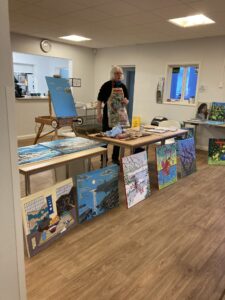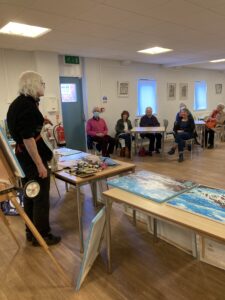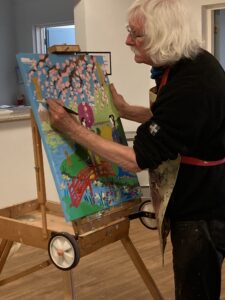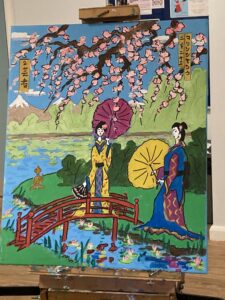Members were completely spoiled with an entertaining and highly amusing demonstration by the wonderful character and artist that is Colin Jack.
From the outset, Colin engaged the audience with his wit and amiable personality and it wasn’t just his Scottish accent that reminded us of Billy Connolly, in fact one of our members commented that he should really go on tour with his art and comedy show that he shared with us.
Colin did let the audience know that he had lost his hearing completely about 15 years ago and joked that he has to keep talking to prevent himself from humming loudly to the ever present music in his head. We were able to ask any questions about his process and technique by writing them down for him.
Originally from Fifeshire, Colin explained that he usually paints in oils, always with an acrylic under painting, but he has different styles and would be showing us his Japanese style in acrylic. He had brought several examples of his work to show his different styles that were on display for members to see during the afternoon.

Colin explained more about the Japanese style of painting, pointing out that the characteristics included no perspective, no light, shade or texture and is presented very flat and stylised compared to western style realism.
Colin, although not professing to be an expert in Japanese culture, gave an interesting insight into the traditional wood block printing they used. His paintings mimic the wood block style in flat acrylic and, as he assured us, come alive when the black outline is added with felt pens at the end.
He was emphatic that he doesn’t want to have a ‘usual style’ as he thinks it would be boring. In fact he even called his exhibition ‘Not My Usual Style’. Colin normally completes 60-70 paintings a year, but did even more during lockdown in 2020. He explained that he doesn’t paint many summer scenes, preferring the other seasons, mainly as he is not a fan of green and summer is too green!
The Japanese style allows bright colours and, in a normally dull world, he enjoys being able to use bright colours. In his painting he included a bright red Torii gate and red bridge along with water lilies that are all typical of Japanese style, but stressed that Japanese style paintings don’t have to be of Japanese scenes.
He added a couple of golden rectangles to his painting to be able to incorporate Japanese writing in his work. He often writes his name in Japanese, which he now remembers how to do without having to look it up. He added cherry blossom by dabbing red and white paint on to the branches without mixing them too much. Cherry blossom stands for beauty and shortness of life and is commonly seen in Japanese style paintings. Colin also added Geishas to the foreground while explaining a little about the often misunderstood role of Geishas in Japanese culture.
In order to demonstrate the outlining method, Colin had brought a mirror image version of his painting to use in case the paint was not quite dry. He started with a thinner pen for background objects, e.g. the clouds and mountains, and used thicker pens for things in the foreground including the reflections on the water. He reserved his thickest pens for prominent objects like the bridge and the Buddha statue.
Throughout his presentation Colin told us very amusing and, as he warned, very slightly rude anecdotes and observations about the brits abroad and his other life experiences.
As well as producing a wonderful, colourful painting, Colin also provided a wonderful, colourful presentation and we can’t wait to welcome him back at some point to entertain us again.



